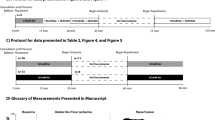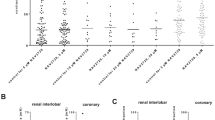Abstract
Initial experiments were designed to determine if vasoactive concentrations of nitric oxide (NO) alter contractility in rat heart. Contractile function was monitored in left atrial and papillary muscles (30 °C; paced at 0.5 Hz) during cumulative addition of 3-morpholino-sydnonimine-HCl(SIN-l), an agent that releases NO. At concentrations between 10−7 and 10−4 M (NO concentrations of approximately 10−8-3 × 10−7 M), SIN-1 did not affect contractility in either tissue. Similarly, 10−4 M SIN-1 did not alter the positive inotropic responses to isoproterenol or increasing extracellular [Ca+2] ([Ca+2]o). To obtain higher concentrations of NO, additional studies were conducted using authentic NO. NO-saturated stock solutions and a corresponding control solvent were adjusted to pH 1.6 with HC1. Dose-dependent effects of NO were examined by adding aliquots of the stock solutions (or control solvent) to the bathing solution. At final concentrations of 1 × 10−5- 5 × 10−4 M, NO produced transient, concentration-dependent decreases in contractility that were paralleled by reductions in buffer pH. Control solvent elicited similar reductions in pH0 and transient decreases in contractility; however, the negative inotropic action elicited by the NO-containing solution was approximately 20% greater than that observed in control conditions. These data demonstrate that only high concentrations of NO depress contractility in isolated rat cardiac muscle, and suggest that this effect is mediated by both acidosis and a pHo-independent mechanism.
Similar content being viewed by others
References
Balligand J-L, Kelly RA, Marsden PA, Smith TW, Michel T (1993) Control of cardiac muscle cell function by an endogenous nitric oxide signaling system. Proc Natl Acad Sci USA 90: 347–351
Balligand J-L, Ungureanu D, Kelly RA, Kobzik L, Pimental D, Michel T, Smith TW (1993) Abnormal contractile function due to induction of nitric oxide synthase in rat cardiac myocytes follows exposure to activated macrophage-conditioned medium. J Clin Invest 91:2314–2319
Brady AJB, Poole-Wilson PA, Harding SE, Warren JB (1992) Nitric oxide production within cardiac myocytes reduces their contractility in endotoxemia. Am J Physiol 263:H1963-H1966
Brady AJB, Warren JB, Poole-Wilson PA, Williams TJ, Harding SE (1993) Nitric oxide attenuates cardiac myocyte contraction. Am J Physiol 265:H176-H182
Bulmenthal DK, Stull JT, Gill GN (1978) Phosphorylation of cardiac troponin by guanosine 3′: 5′-monophosphate-dependent protein kinase. J Biol Chem 253:334–336
Butler AR, Flitney FW, Williams DL (1995) NO, nitrosium ions, nitroxide ions, nitrosothiols, and iron-nitrosyls in biology: a chemist’s perspective. Trends Pharmacol Sci 16:18–22
Ding AH, Nathan CF, Stuehr DJ (1988) Release of reactive nitrogen intermediates and reactive oxygen intermediates from mouse peritoneal macrophages. Comparison of activating cytokines and evidence for independent production. J Immunol 141:2407–2412
Duprat AF, Traylor TG, Wu GZ, Coletta M, Sharma VS, Walda KN, Magde D (1995) Myoglobin-NO at low pH. Free four-coordinated heme in the protein pocket. Biochemistry 34:2634–2644
Feelisch M, Noack EA (1987) Correlation between nitric oxide formation during degradation of organic nitrates and activation of guanylate cyclase. Eur J Pharmacol 139:19–30
Flitney FW, Singh J (1981) Evidence that cyclic GMP may regulate cyclic AMP metabolism in the isolated frog ventricle. J Mol Cell Cardiol 13:963–979
Hartzell HC, Fischmeister R (1986) Opposite effects of cyclic GMP and cyclic AMP on Ca+2 current in single heart cells. Nature 323:273–275
Henderson AH, Lewis MJ, Shah AM, Smith JA (1992) Endothelium, endocardium, and cardiac contraction. Cardiovasc Res 26:305–308
Ishibashi T, Hamaguchi M, Kato K, Kawada T, Ohta H, Sasage H, Imai S (1993) Relationship between myoglobin contents and increases in cyclic GMP produced by glyceryl trinitrate and nitric oxide in rabbit aorta, right atrium and papillary muscle. Naunyn-Schmiedebergs Arch Pharmacol 347:553–561
Kennedy RH, Akera T, Brody TM (1987) The effect of stimulation frequency and calcium concentration on maintenance of developed tension in isolated heart muscle preparations. J Pharmacol Methods 17:95–110
Kennedy RH, Hicks KK, Brian JE Jr, Seifen E (1994) Nitric oxide has no chronotropic effect in right atria isolated from rat heart. Eur J Pharmacol 255:149–156
Kirstein M, Rivet-Bastide M, Hatem S, Bénardeau A, Mercadier J-J, Fischmeister R (1995) Nitric oxide regulates the calcium current in isolated human atrial myocytes. J Clin Invest 95:794–802
Klabunde RE, Kimber ND, Kuk JE, Helgren MC, Förstermann U (1992) NG-methyl-L-arginine decreases contractility, cGMP and cAMP in isoproterenol-stimulated rat hearts in vitro. Eur J Pharmacol 223:1–7
Lefer DJ, Ma XL, Lefer AM, Nakanishi K, Vinten-Johansen J (1993) Lack of inotropic effects of nitric oxide donors in cat and dog myocardium (abstract). FASEB J 7:A244
Lincoln TM, Corbin JD (1983) Characterization and biological role of the cGMP-dependent protein kinase. Adv Cyclic Nucleotide Res 15:139–192
Méry PF, Lohmann SM, Walter U, Fischmeister R (1991) Ca+2 current is regulated by cyclic GMP-dependent protein kinase in mammalian cardiac myocytes. Proc Natl Acad Sci USA 88:1197–1201
Méry PF, Pavoinet C, Belhassen L, Pecker F, Fischmeister R (1993) Nitric oxide regulates cardiac Ca2+ current. Involvement of cGMP-inhibited and cGMP-stimulated phosphodiesterases through guanyly cyclase activation. J Biol Chem 268: 26286–26295
Moncada S, Palmer RMJ, Higgs EA (1991) Nitric oxide: physiology, pathophysiology and pharmacology. Pharmacol Rev 43:109–141
Nawrath H (1977) Does cyclic GMP mediate the negative inotropic effect of acetylcholine in the heart? Nature 267:72–74
Orchard CH, Kentish JC (1990) Effects of pH on the contractile function of cardiac muscle. Am J Physiol 258:C967-C981
Schmidt HH, Lohmann SM, Walter U (1993) The nitric oxide and cGMP signal transduction system: Regulation and mechanism of action. Biochim Biophys Acta 1178:153:175
Shah AM, Spurgeon HA, Sollott SJ, Talo A, Lakatta EG (1994) 8-Bromo-cGMP reduces the myofilament response to Ca2+ in intact cardiac myocytes. Circ Res 74:970–978
Shibuki K (1990) An electrochemical microprobe for detecting nitric oxide release in brain tissue. Neurosci Res 9:69–76
Smith JA, Shah AM, Lewis MJ (1991) Factors released from endocardium of the ferret and pig modulate myocardial contraction. J Physiol (Lond) 439:1–14
Tsukahara H, Gordienko DV, Goligorsky MS (1993) Continuous monitoring of nitric oxide release from human umbilical vein endothelial cells. Biochem Biophys Res Commun 193:722–729
Wahler GM, Dollinger SJ (1995) Nitric oxide donor SIN-1 inhibits mammalian cardiac calcium current through cGMP-dependent protein kinase. Am J Physiol 268:C45-C54
Weyrich AS, Ma X-L, Buerke M, Murohara T, Armstead VE, Lefer AM, Nicolas JM, Thomas AP, Lefer DJ, Vinten-Johansen J (1994) Physiological concentrations of nitric oxide do not elicit an acute negative inotropic effect in unstimulated cardiac muscle. Circ Res 75:692–700
Wink DA, Darbyshire JF, Nims RW, Saavedra JE, Ford PC (1993) Reactions of the bioregulatory agent nitric oxide in oxygenated aqueous media: determination of the kinetics for oxidation and nitrosation by intermediates generated in the NO/O2 reaction. Chem Res Toxicol 6:23–27
Wood J, Garthwaite J (1994) Models of the diffusional spread of nitric oxide: implications for neural nitric oxide signalling and its pharmacological properties. Neuropharmacology 33: 1235–1244
Author information
Authors and Affiliations
Rights and permissions
About this article
Cite this article
Wyeth, R.P., Temma, K., Seifen, E. et al. Negative inotropic actions of nitric oxide require high closes in rat cardiac muscle. Pflügers Arch. 432, 678–684 (1996). https://doi.org/10.1007/s004240050185
Received:
Accepted:
Published:
Issue Date:
DOI: https://doi.org/10.1007/s004240050185




